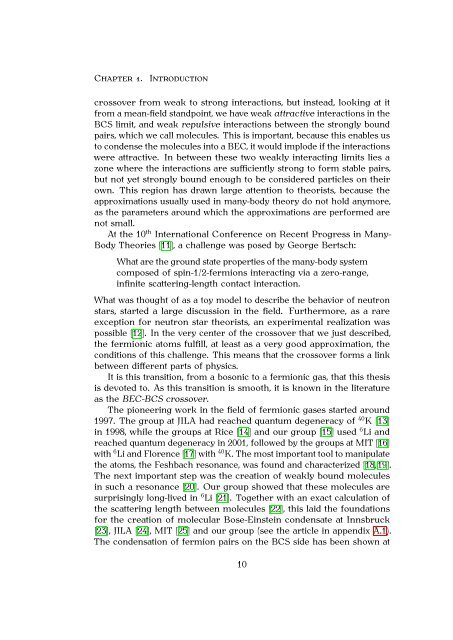Martin Teichmann Atomes de lithium-6 ultra froids dans la ... - TEL
Martin Teichmann Atomes de lithium-6 ultra froids dans la ... - TEL
Martin Teichmann Atomes de lithium-6 ultra froids dans la ... - TEL
You also want an ePaper? Increase the reach of your titles
YUMPU automatically turns print PDFs into web optimized ePapers that Google loves.
CHAPTER 1. INTRODUCTION<br />
crossover from weak to strong interactions, but instead, looking at it<br />
from a mean-field standpoint, we have weak attractive interactions in the<br />
BCS limit, and weak repulsive interactions between the strongly bound<br />
pairs, which we call molecules. This is important, because this enables us<br />
to con<strong>de</strong>nse the molecules into a BEC, it would implo<strong>de</strong> if the interactions<br />
were attractive. In between these two weakly interacting limits lies a<br />
zone where the interactions are sufficiently strong to form stable pairs,<br />
but not yet strongly bound enough to be consi<strong>de</strong>red particles on their<br />
own. This region has drawn <strong>la</strong>rge attention to theorists, because the<br />
approximations usually used in many-body theory do not hold anymore,<br />
as the parameters around which the approximations are performed are<br />
not small.<br />
At the 10 th International Conference on Recent Progress in Many-<br />
Body Theories [11], a challenge was posed by George Bertsch:<br />
What are the ground state properties of the many-body system<br />
composed of spin-1/2-fermions interacting via a zero-range,<br />
infinite scattering-length contact interaction.<br />
What was thought of as a toy mo<strong>de</strong>l to <strong>de</strong>scribe the behavior of neutron<br />
stars, started a <strong>la</strong>rge discussion in the field. Furthermore, as a rare<br />
exception for neutron star theorists, an experimental realization was<br />
possible [12]. In the very center of the crossover that we just <strong>de</strong>scribed,<br />
the fermionic atoms fulfill, at least as a very good approximation, the<br />
conditions of this challenge. This means that the crossover forms a link<br />
between different parts of physics.<br />
It is this transition, from a bosonic to a fermionic gas, that this thesis<br />
is <strong>de</strong>voted to. As this transition is smooth, it is known in the literature<br />
as the BEC-BCS crossover.<br />
The pioneering work in the field of fermionic gases started around<br />
1997. The group at JILA had reached quantum <strong>de</strong>generacy of 40 K [13]<br />
in 1998, while the groups at Rice [14] and our group [15] used 6 Li and<br />
reached quantum <strong>de</strong>generacy in 2001, followed by the groups at MIT [16]<br />
with 6 Li and Florence [17] with 40 K. The most important tool to manipu<strong>la</strong>te<br />
the atoms, the Feshbach resonance, was found and characterized [18,19].<br />
The next important step was the creation of weakly bound molecules<br />
in such a resonance [20]. Our group showed that these molecules are<br />
surprisingly long-lived in 6 Li [21]. Together with an exact calcu<strong>la</strong>tion of<br />
the scattering length between molecules [22], this <strong>la</strong>id the foundations<br />
for the creation of molecu<strong>la</strong>r Bose-Einstein con<strong>de</strong>nsate at Innsbruck<br />
[23], JILA [24], MIT [25] and our group (see the article in appendix A.1).<br />
The con<strong>de</strong>nsation of fermion pairs on the BCS si<strong>de</strong> has been shown at<br />
10

















